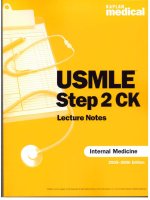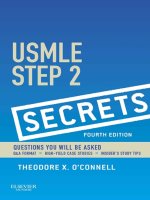Deja Review USMLE Step 2 CK, 2nd Edition
Bạn đang xem bản rút gọn của tài liệu. Xem và tải ngay bản đầy đủ của tài liệu tại đây (1.24 MB, 301 trang )
DEJAREVIEWTM
USMLEStep2CK
NOTICE
Medicine is an ever-changing science. As new research and clinical experience broaden our knowledge, changes in
treatmentanddrugtherapyarerequired.Theauthorsandthepublisherofthisworkhavecheckedwithsourcesbelievedto
bereliableintheireffortstoprovideinformationthatiscompleteandgenerallyinaccordwiththestandardsacceptedatthe
timeofpublication.However,inviewofthepossibilityofhumanerrororchangesinmedicalsciences,neithertheauthors
northepublishernoranyotherpartywhohasbeeninvolvedinthepreparationorpublicationofthisworkwarrantsthatthe
informationcontainedhereinisineveryrespectaccurateorcomplete,andtheydisclaimallresponsibilityforanyerrorsor
omissionsorfortheresultsobtainedfromuseoftheinformationcontainedinthiswork.Readersareencouragedtoconfirm
theinformationcontainedhereinwithothersources.Forexampleandinparticular,readersareadvisedtochecktheproduct
informationsheetincludedinthepackageofeachdrugtheyplantoadministertobecertainthattheinformationcontained
in this work is accurate and that changes have not been made in the recommended dose or in the contraindications for
administration.Thisrecommendationisofparticularimportanceinconnectionwithneworinfrequentlyuseddrugs.
DEJAREVIEWTM
USMLEStep2CK
SecondEdition
JohnH.Naheedy,MD
Fellow,PediatricRadiologyDepartmentofRadiology
Children’sHospitalBoston
HarvardMedicalSchool
Boston,Massachusetts
DanielA.Orringer,MD
ChiefResident
DepartmentofNeurosurgery
UniversityofMichiganMedicalSchool
AnnArbor,Michigan
KhashayarMohebali,MD
ChiefResident,ClinicalInstructor
DivisionofPlasticandReconstructiveSurgery
DepartmentofSurgery
UniversityofCalifornia,SanFranciscoSanFrancisco,California
PeterF.Aziz,MD
Fellow-PediatricCardiology
DepartmentofPediatrics
Children’sHospitalofPhiladelphia
Philadelphia,Pennsylvania
SusieLim,MD
ClinicalInstructor
ObstetricsandGynecology
KaiserPermanenteNorthwest
Portland,Oregon
Copyright©2010,2006byJohnH.Naheedy,DanielA.Orringer,KhashayarMohebali,PeterF.Aziz,andSusieLim.All
rights reserved. Except as permitted under the United States Copyright Act of 1976, no part of this publication may be
reproducedordistributedinanyformorbyanymeans,orstoredinadatabaseorretrievalsystem,withoutthepriorwritten
permissionofthepublisher.
ISBN:978-0-07-163941-5
MHID:0-07-163941-1
ThematerialinthiseBookalsoappearsintheprintversionofthistitle:ISBN:978-0-07-162716-0,MHID:0-07-162716-2.
Alltrademarksaretrademarksoftheirrespectiveowners.Ratherthanputatrademarksymbolaftereveryoccurrenceofa
trademarkedname,weusenamesinaneditorialfashiononly,andtothebenefitofthetrademarkowner,withnointention
ofinfringementofthetrademark.Wheresuchdesignationsappearinthisbook,theyhavebeenprintedwithinitialcaps.
McGraw-Hill eBooks are available at special quantity discounts to use as premiums and sales promotions, or for use in
corporatetrainingprograms.Tocontactarepresentativepleasee-mailusat
TERMSOFUSE
ThisisacopyrightedworkandTheMcGraw-HillCompanies,Inc.(“McGraw-Hill”)anditslicensorsreserveallrightsin
andtothework.Useofthisworkissubjecttotheseterms.ExceptaspermittedundertheCopyrightActof1976andthe
righttostoreandretrieveonecopyofthework,youmaynotdecompile,disassemble,reverseengineer,reproduce,modify,
createderivativeworksbasedupon,transmit,distribute,disseminate,sell,publishorsublicensetheworkoranypartofit
withoutMcGraw-Hill’spriorconsent.Youmayusetheworkforyourownnoncommercialandpersonaluse;anyotheruse
oftheworkisstrictlyprohibited.Yourrighttousetheworkmaybeterminatedifyoufailtocomplywiththeseterms.
THE WORK IS PROVIDED “AS IS.” McGRAW-HILL AND ITS LICENSORS MAKE NO GUARANTEES OR
WARRANTIES AS TO THE ACCURACY, ADEQUACY OR COMPLETENESS OF OR RESULTS TO BE
OBTAINED FROM USING THE WORK, INCLUDING ANY INFORMATION THAT CAN BE ACCESSED
THROUGH THE WORK VIA HYPERLINK OR OTHERWISE, AND EXPRESSLY DISCLAIM ANY WARRANTY,
EXPRESSORIMPLIED,INCLUDINGBUTNOTLIMITEDTOIMPLIEDWARRANTIESOFMERCHANTABILITY
OR FITNESS FOR A PARTICULAR PURPOSE. McGraw-Hill and its licensors do not warrant or guarantee that the
functionscontainedintheworkwillmeetyourrequirementsorthatitsoperationwillbeuninterruptedorerrorfree.Neither
McGraw-Hill nor its licensors shall be liable to you or anyone else for any inaccuracy, error or omission, regardless of
cause, in the work or for any damages resulting there from. McGraw-Hill has no responsibility for the content of any
informationaccessedthroughthework.UndernocircumstancesshallMcGraw-Hilland/oritslicensorsbeliableforany
indirect, incidental, special, punitive, consequential or similar damages that result from the use of or inability to use the
work,evenifanyofthemhasbeenadvisedofthepossibilityofsuchdamages.Thislimitationofliabilityshallapplytoany
claimorcausewhatsoeverwhethersuchclaimorcausearisesincontract,tortorotherwise.
Tomyfamilyandfriends,fortheirloveandencouragement;andtomyparents,forbeinganexampleofeverythingI
wanttobe.
—John
ToMegan,thetrueauthorinthefamily.
—Dan
Tomyparentsfordedicatingandsacrificingtheirlivestomakeminebetterandtomyfriendsfortheirinvaluable
loyalty.
—Khashi
Tomyfamily,forteachingmethattheloveofmedicinecanbegeneticallyinherited;andtothebunker,thesandtrapof
myclosestfriends,thanksfortheinspiration.
—Pete
ToMichael,OliverandSoë
—Susie
Contents
Contributors
Reviewers
Preface
Acknowledgments
Chapter1INTERNALMEDICINE
Cardiology
Pulmonary
InfectiousDiseases
Gastroenterology
Renal/Genitourinary
Endocrine
Hematology/Oncology
Rheumatology/Musculoskeletal
Dermatology
PreventativeMedicine,Ethics,andBiostatistics
Chapter2SURGERY
Trauma
GeneralSurgery
VascularSurgery
Orthopedics
AbdominalPain
MaketheDiagnosis
Chapter3NEUROLOGY
Headache
Seizures
CerebralVasculature
IntracranialHemorrhage
BrainTumors
CNSInfections
CognitiveDisorders
MovementDisorders
AmyotrophicLateralSclerosis,MultipleSclerosis,andotherDemyelinatingDiseases
Vertigo
NeuromuscularDisease
Ophthalmology
Syncope
PeripheralNeuropathy
LocalizetheLesion
MaketheDiagnosis
CHAPTER4PSYCHIATRY
MoodDisorders
SuicideandViolence
PsychoticDisorders
AnxietyDisorders
SomatoformDisorders
EatingDisorders
SubstanceAbuse
ChildhoodDisorders
PersonalityDisorders
MiscellaneousPsychiatricDisorders
Psychopharmacology
MaketheDiagnosis
Chapter5OBSTETRICSANDGYNECOLOGY
Obstetrics
Antepartum
Intrapartum
Postpartum
Gynecology
GynecologyOncology
ReproductiveEndocrinology
Urogynecology
MaketheDiagnosis
Chapter6PEDIATRICS
GeneticDefects
CongenitalHeartDisease
Development
ImmunodefiencySyndromes
ChildAbuse
Neonatology
InfectiousDisease
Nephrology
Gastroenterology
Endocrinology
Hematology
Pulmonology
Oncology
Rheumatology
Neurology
Miscellaneous
MaketheDiagnosis
Chapter7EMERGENCYMEDICINE
Trauma
Toxicology
EnvironmentalEmergencies
MaketheDiagnosis
AppendixABBREVIATIONS
Index
Contributors
KarlaFredricks,MD
Resident
DepartmentofPediatrics
Children’sHospitalofPhiladelphia
Philadelphia,Pennsylvania
Chapter:Pediatrics
EmilyY.Fukuchi,MD
Resident
DepartmentofObstetricsandGynecology
UniversityofCalifornia,SanFrancisco
SanFrancisco,California
Chapters:InternalMedicine,Surgery
KarenA.Kinnaman,MD
UniversityofMichiganMedicalSchool
AnnArbor,Michigan
Classof2009
Chapter:EmergencyMedicine
VijayPottathil,MD
Resident
DepartmentofInternalMedicine
UniversityofIowa
IowaCity,Iowa
Chapter:InternalMedicine
JaysonSack,MD
Resident
DepartmentofNeurosurgery
UniversityofSouthFlorida
Tampa,Florida
Chapters:Neurology,Psychiatry
MiguelTrujillo,MD
Resident
DepartmentofObstetricsandGynecology
OregonHealthandScienceUniversity
Portland,Oregon
Chapter:ObstetricsandGynecology
Reviewers
JessicaBury,MPH
MedicalStudent
MayoClinicalCollegeofMedicine
Classof2010
TinaNguyen,MD
Resident,EmergencyMedicine
HarborUCLAMedicalCenter
UniversityofCaliforniaLosAngeles
SUNYUpstateMedicalUniversity
Classof2008
Preface
DéjàReview™USMLEStep2CKhasbeenscrutinizedandeditedtoproduceasecondeditionthatisevenhigheryieldand
easiertousethanthefirst.Outstandingmedicalstudents,whohaverecentlytakenStep2,revisedtheoriginaltexttoensure
the material covered herein is complete and current. The authors, now with a combined 30 years of experience in the
medicalfield,havealsoeditedthemanuscripttoemphasizetheclinicalrelevanceofthecoreconceptscoveredinStep2.
WeareconfidentthatoureffortshaveproducedoneofthemostusefulguidesforStep2reviewavailabletoday.
Step2oftheUnitedStatesMedicalLicensingExamination(USMLE)teststheseniormedicalstudent’sabilitytoapplythe
basicprinciplesofclinicalmedicine.However,beforeyoucanapplythoseprinciples,youmustbeabletorapidlyrecalla
corebodyofessentialfacts.ThisiswhytheDéjàReviewseriesisthemostefficient,well-organized,portable,andabove
all,high-yieldresourcetopreparestudentsfortheUSMLE.AsrecentgraduateswhohavetakenStep2,weareconfident
thatwehavecompiledanovelreviewguidethatpromotesrapidrecallofalloftheessentialfactsnecessaryforsuccesson
thisexamination.Wealsorealizethatasolidfoundationintheseprincipleswillallowyoutomakeasmoothtransitioninto
yourresidency.
ORGANIZATION
All concepts are presented in a question and answer format that covers the key facts on hundreds of common and
uncommondiseases.Thematerialisdividedintochapterscoveringthesixmajordivisionsofclinicalmedicine:internal
medicine,surgery,neuroscience,psychiatry,OB/GYN,andpediatrics.Wehavealsoincludedabriefemergencymedicine
chapterthataddressestopicsnotcoveredunderemergentconditionsineachoftheotherchapters.
Thisquestionandanswerformathasseveralimportantadvantages:
•Itprovidesarapid,straightforwardwayforyoutoassessyourstrengthsandweaknesses.
•Itallowsyoutoefficientlyreviewandcommittomemoryalargebodyofinformation.
•Itwillprepareyouforgetting“pimped”byresidentsandattendingsonthewards.
•Itoffersyouabreakfromtedious,convolutedmultiple-choicequestions.
• The clinical vignettes will expose you to the prototypic presentation of diseases classically tested on the USMLE
Step2.
•Itservesasaquick,last-minutereviewofhigh-yieldfacts.
The compact, condensed design of the book is conducive to studying on the go, especially during any downtime on the
wards.
HOWTOUSETHISBOOK
Remember,thistextisnotintendedtoreplacetextbooks,coursepacks,orlectures.Itis,however,intendedtoserveasa
supplementtoyourstudiesduringthethirdandfourthyearsofmedicalschool.Thistexthasbeensampledandrefinedbya
numberofmedicalstudentswhofoundittobeanessentialpartoftheirpreparationfortheUSMLEshelfexaminations,in
additiontoStep2itself.We recommendhavingthetextspiral boundtomakeitmore portableandeasiertouse. Begin
using this book early in your third year by carrying it with you during your clinical clerkships. You may cover up the
answerswiththeincludedbookmarkandquizyourselforevenyourclassmates.Foragreaterchallenge,trycoveringupthe
questions!
Howeveryouchoosetostudy,wehopeyoufindthisresourcehelpfulduringyourpreparationfortheUSMLEStep2and
throughoutyourclinicalrotations.Bestofluck!
JohnH.Naheedy,MD
DanielA.Orringer,MD
KhashayarMohebali,MD
PeterF.Aziz,MD
SusieLim,MD
Acknowledgments
Theauthorswouldliketothankthefollowingindividualsfortheirinvaluablecontributionstothistextandtheireffortsin
makingthisausefulresourceforstudents:
DeborahA.Bartholomew,MD
ClinicalAssociateProfessor
DepartmentofObstetricsandGynecology
OhioStateUniversityMedicalCenter
Columbus,Ohio
PeterMuscarellaII,MD
AssistantProfessor,Clinical
DepartmentofSurgery
OhioStateUniversityMedicalCenter
Columbus,Ohio
EmileEl-Shammaa,MD
AssistantProfessor,Clinical
DepartmentofEmergencyMedicine
DepartmentofPediatrics
Columbia,Ohio
OhioStateUniversityMedicalCenter
Columbus,Ohio
TheauthorswouldliketorecognizethefacultyandstaffattheOhioStateUniversityCollegeofMedicinefortheirendless
commitmenttoeducation.WithoutthewisdomandencouragementofmentorslikethelateJohnM.Stang,MD,thisproject
wouldnothavebeenpossible.Wewouldalsoliketothankthestudentswhousedthistextinpreparationfortheirboards
andprovidedfeedbackessentialtooptimizingthistext.Finally,specialthankstoourmanagingeditorKirstenFunkforher
dedicationandpatience.
CHAPTER1
InternalMedicine
CARDIOLOGY
Hypertension
Whatpercentageofhypertensivepatientshaveessentialhypertension(HTN)?
90%-95%
Namethecauseofsecondary(2°)HTNinthefollowingclinicalscenarios:
HTNupperextremities;decreasedornormalbloodpressure(BP)inlowerextremities
Coarctationoftheaorta
HTNaccompaniedbyproteinuriainanondiabeticpatient
Glomerulardisease
HTNinapatientwithahistoryof(h/o)renalandhepaticcysts
Polycystickidneydisease
SuddenworseningofHTNinanelderlymalewithcoronaryarterydisease(CAD)andperipheralvascular
disease(PVD)
Renalarterystenosis
EpisodicHTN,weightloss,headache,anddiaphoresis
Pheochromocytoma
ElevatedsystolicHTNwithoutdiastolicHTN
Hyperthyroidism
40-year-old(y/o)femalewithah/o20yearsoforalcontraceptivepills(OCP)use
Drug-induced(OCP)HTN
HTNinapatientwithhypokalemicmetabolicalkalosis
Connsyndrome/hyperaldosteronism
HTNinanoverweightpatientwithbuffalohump,moonfacies,hirsutism,andabdominalstriae
Cushingsyndrome
Whatisthedifferencebetweenhypertensiveurgencyandhypertensiveemergency?
Inhypertensiveurgencytherearenosignsofend-organdamageduetoHTN.Inhypertensiveemergencythereare
signsoforgandamage(papilledema,renalfailure,heartfailure,stroke).
Whatisthetreatmentofhypertensiveurgency?
OralBPmedication(labetalol,captopril,clonidine)
Whatarethethreepreferredagentsforthetreatmentofhypertensiveemergency?
1.IVnitroprusside
2.Nitroglycerine
3.Hydralazine
Whatisthepreferredtreatmentforhypertensioninpregnancy?
Hydralazineandclonidineormethyldopa
Foreachofthefollowingconditions,selectthebestantihypertensiveagent(s):
Nocomorbidities
Diureticsorβ-blockers
IsolatedsystolicHTN
Thiazidediuretics
Anginapectoris
β-Blockers,calciumchannelblockers
Diabetes
Angiotensin-convertingenzymeinhibitors(ACEi)orangiotensinreceptorblocker(ARB),β-blockers
Hyperlipidemia
ACEi,calciumchannelblockers
Congestiveheartfailure(CHF)
Diuretics,ACEi
H/omyocardialinfarction(MI)
β-blockers,ACEi
Chronicrenalfailure
Diuretics,calciumchannelblockers
Asthma,chronicobstructivepulmonarydisease(COPD)
Diuretics,calciumchannelblockers
Benignprostatichyperplasia(BPH)
α1-selectiveantagonist(terazosin)
Pheochromocytoma
Phenoxybenzamine(α1α2-antagonist),phentolamine(α1-blocker)
Hypertrophicobstructivecardiomyopathy
β-blockers
Hyperthyroidism
β-blockers
Anxiety
β-blockers
Supraventriculartachycardia(SVT)
β-blockers
Migraineheadaches
β-blockers,calciumchannelblockers
Moderatebradycardia
β-blockerswithintrinsicsympathomimeticactivity:pindololandacebutolol
Osteoporosis
Thiazidediuretics(reabsorbsCa2+)
Foreachofthefollowingconditions,listtheantihypertensiveagent(s)thatshouldbeusedwithcaution:
CHF
Verapamil,α-blockers
Asthma,COPD
β-blockers
Diabetes
β-blockers,thiazides
Renalarterystenosis,renalfailure
ACEinhibitors
Hypercholesterolemia
Whatgeneticdiseaseshouldbesuspectedinapatientwithxanthomas,xanthelasmas,andlipemiaretinalis?
Familialhypercholesterolemia
State the recommended therapeutic intervention or further workup (w/u) for patients with the following lipid
values:
Totalcholesterol200
Retestin5years
Totalcholesterol>200
Treatbasedonlipidfractions
Low-densitylipoprotein(LDL)>190
Beginlipid-loweringtherapy(goal160)
LDL>160inapatientwithtwoormorecoronaryriskfactors
Beginlipid-loweringtherapy(goal130)
LDL>130inapatientwithCADordiabetesmellitus(DM)
Beginlipid-loweringtherapy(goal100)
LDL>100inapatientwithapreviousMI
Beginlipid-loweringtherapy
Triglycerides(TGs)>200
BeginTG-loweringtherapy
For each of the following drugs, provide: (1) the mechanism of action (MOA), (2) indication(s) (IND), and (3)
significantsideeffectsanduniquetoxicity(TOX)(ifany):
Cholestyramine
MOA:bile-acid-bindingresin
IND:adjuvanttherapyforpatientswithfamilialhypercholesterolemia
TOX:constipation,gastrointestinal(GI)discomfort,mayinterferewithintestinalabsorptionofotherdrugs
Statins
MOA:hydroxymethylglutaryl(HMG)coenzymeA(CoA)reductaseinhibitors
IND:hypercholesterolemia
TOX:hepatotoxicity,rhabdomyolysis
Niacin
MOA:reducesreleaseofverylow-densitylipoprotein(VLDL)fromliverintocirculation
IND:hypercholesterolemia:to↑high-densitylipoprotein(HDL)and↓LDL
TOX:flushing,pruritus(bothreversiblewithaspirin),andhepatotoxicity
Gemfibrozil,clofibrate
MOA:stimulateslipoproteinlipase
IND:hypercholesterolemia:to↓↓TGs
TOX:myositis,hepatotoxicity
CoronaryArteryDisease
Whicharethesixcoronaryriskfactors?
CADHDL
1.Cigarettes
2.Age(males>45andfemales>55areatincreasedrisk)andsex(males>females)
3.Diabetesmellitus(greatestriskfactor)
4.HTN
5.DeathfromMIinfamilyhistory(FH)(males55y/o,females60y/o)
6.↑LDL,lowHDL(35)
WhatisthecommonpresentationofapatientwithsymptomaticCAD?
Angina pectoris ± radiation to jaw, left shoulder, or arm; exacerbated by exertion, relieved by rest, and
nitroglycerin
Whichgroupsofpatientscommonlydonotexhibitclassicanginalsymptomsinthesettingofmyocardialischemia?
Elderly,women,anddiabetics(duetodiabeticneuropathy,hearttransplantpatients)
Whichtypeofanginaischaracterizedbychestpainanddyspneaatrest?
Unstableangina
WhataretheclassicECGfindingsduringananginalepisode?
>1-mmST-segmentdepressionandT-waveinversion
WhatdiagnostictestsareoftenusedtoscreenforCAD?
Exerciseorpharmacologicstresstestorimaging
WhichpatientsshouldundergoexerciseECGw/myocardialimaging+stressechointheworkupofCAD?
Patients with Wolf-Parkinson-White syndrome, >1-mm ST depression on resting ECG; hx of percutaneous
transluminalcoronaryangioplasty(PTCA),onDigoxin,orthosewithleftventricularhypertrophy(LVH)
Whogetspharmacologicstresstest?
Patientswithelectronicallypacedventricularrhythmandleftbundlebranchblock(LBBB)
WhatisthegoldstandardforthediagnosisofCAD?
Coronaryarteriography
NamesixlifestylechangesthatshouldbesuggestedtoallpatientswithHTN:
1.Weightloss
2.Sodiumrestriction
3.Physicalexercise
4.Smokingcessation
5.Alcoholcessation
6.Stressreduction
Whatmedicationsshouldbegiventoapatientwithacuteonsetofangina?
Sublingualnitroglycerin
WhatmedicationsshouldbegivenasprophylaxisforanginaandMI?
Long-actingnitrates,β-blockers,ASA,statin(andACEIinpatientswithh/oMI)
Whatarethekeystepsinthemedicalmanagementofapatientwithunstableangina?
StartIV,administerO2,startheparin,ASA,β-blocker,nitroglycerin,morphine
Describehownitratesreduceangina:
1.Venodilationcausesvenouspooling→↓preload→↓myocardialO2consumption
2.Coronaryvasodilation→↑O2deliverytothemyocardium
Whatisthemostcommonsideeffectofnitrates?
Headache
Describehoweachofthefollowingdrugsreducesangina:
β-Blockers
↓MyocardialO2use,↓afterload,↑coronaryfillingduringdiastole
Nifedipine
Coronaryarteriolarvasodilation
Verapamil
Slowscardiacconduction
Whatistheantianginaldrugofchoiceforprinzmetalangina?
Diltiazem
WhichantianginaldrugmustbeusedwithcautioninpatientswithasthmaandCOPD?
β-blockers
Whatinterventionisreservedforpatientswhoseanginacannotbecontrolledmedically?
Percutaneoustransluminalcoronaryangioplasty(PTCA)
Whataretheindicationsforcoronaryarterybypassgrafting?
Anginarefractorytomedicaltherapy,severeleftmaindisease,andtriplevesselcoronarydisease(ordoublevessel
diseaseinadiabetic)
MyocardialInfarction
WhatisthecommonpresentationofMI?
Crushing retrosternal chest pressure occurring at rest and radiating to left arm, neck, or jaw; diaphoresis;
nausea/vomiting;dyspnea;andanxiety
WhatisacommonphysicalexaminationfindingduringanMI?
S4gallop
Whicharethesixlife-threateningcausesofchestpainthatmustberuledoutinallpatients?
1.MI
2.Aorticdissection
3.Pulmonaryembolism(PE)
4.Pneumothorax(PTX)
5.Esophagealrupture
6.Cardiactamponade
WhatarethekeystepsintheinitialmanagementofapatientwithsuspectedMI?
Assessvitalsigns,administerO2,startIV,placeoncardiacmonitor,andobtainECG;administerASA,heparin,
nitrates,β-blockers,morphine,clopidogrel
WhataretheclassicECGabnormalitiesinanacuteMI?
STelevationandQwaves
WhichECGfindingisverysensitiveandspecificforrightventricularinfarction?
STelevationof1mminright-sidedleadV4
WhichcoronaryarteryislikelytobeoccludedinapatientwiththefollowingECGabnormalities?
LargeRandST-segmentdepressioninV1,V2
Rightcoronary(posteriorinfarction)
QwavesandST-segmentelevationinleadsV1-V4
Leftanteriordescending(anteriorinfarction)
QwaveinleadsI,aVL,V5,V6
Circumflex(lateralinfarction)
QwavesandSTelevationinleadsII,III,aVF
Rightcoronary(inferiorinfarction)
WhichserologicmarkersaretypicallyusedtodiagnoseandfollowanMI?
TroponinIandCK-MB
WhatmedicationisreservedforpatientswithMIsufferingfromanginathatisrefractorytoconventionalmedical
management?
Thrombolyticsincludingtissueplasminogenactivatororstreptokinase
WhatinterventionisindicatedinpatientsduringanMIwhofailorcannottoleratethrombolytictherapy?
PTCA
WhataretheclinicalmanifestationsofrightventricularMI?
ECGinf.changes,hypotension,clearlungs,jugularvenousdistension(JVD),rightventricularlift,tricuspidvalve
regurgitation
Whichmedicaltherapyshouldbeavoidedinapatientwitharightventricularinfarction?
Nitroglycerin(initialtherapyshouldinvolveIVfluidsto↑preload)
Whatlong-termmedicationshavebeenshowntoimprovemortalityinpatientswithMI?
ASAandβ-blockers(acutely);ACEI,statins,andclopidogrel(longterm)
Arrhythmias
Namethearrhythmiaassociatedwiththefollowingclinicalfeatures:
PRinterval>0.2s,oftenduetoincreasedvagaltone
Primary(1°)heartblock
PRintervalgraduallyincreasestothepointatwhichaQRScomplexisdropped(Pwaveisnotconducted).
2°MobitztypeIheartblock(Wenkebach)
PRinterval>0.2swithoccasionaldroppingoftheQRScomplexatafixedinterval(ie,2:1or3:1)
2°MobitztypeIIheartblock
IrregularlyirregularpulsesandQRScomplexes
Atrialfibrillation
Typeofheartblockthatcommonlyarisesasasideeffectofmedicationincludingβ-blockers,digoxin,and
calciumchannelblockers
2°MobitztypeIIheartblock
SawtoothappearanceofPwaves
Atrialflutter
UsuallycausedbyconductionblockwithinthebundleofHis
2°MobitztypeIIheartblock
CompletedissociationbetweenPwavesandQRScomplexes
3°orcompleteheartblock
ThreeormoreP-wavemorphologies
MultifocalatrialtachycardiaifHR>100,wanderingpacemakerifHR100
AssociatedwithcannonAwavesinjugularveinsandwidenedpulsepressure
3°heartblock
IrregularlyirregularpulsesandQRScomplexes
Atrialfibrillation
Commonlycausedbyreentry
ParoxsymalSVT
AssociatedwithCOPD
Atrialfibrillation,atrialflutter,multifocalatrialtachycardia
Treatmentcommonlyincludesanticoagulation,ratecontrol,and/orcardioversion.
Atrialfibrillation
WideQRScomplexesnotprecededbyaPwave
Prematureventricularcontraction(PVC)
NormalQRSmorphologywitharateof150-200beats/min
ParoxsymalSVT
Pharmocologictreatmentincludesamiodarone,lidocaine,andprocainamide.
Ventriculartachycardia
MaybetreatedwithcarotidmassageorValsalvamaneuver
ParoxsymalSVT
CommoncauseofpalpitationcausedbyectopicbeatsarisingfrommultipleVentricularfoci
PVC
Ventricular arrhythmia commonly caused by myocardial ischemia that may lead to hemodynamic
instability
Ventriculartachycardia
First-linetherapyisdefibrillation;second-linetherapyisepinephrineorvasopressin.
Ventricularfibrillationandpulselessventriculartachycardia
PolymorphicwidecomplextachycardiaassociatedwithprolongedQTinterval
Torsadedepointes
Treatedidenticaltoventricularfibrillationifthereisnopulse
Ventriculartachycardia
Tachyarrhythmiatreatedwithadenosine,verapamil,cardioversion,orradiofrequencyablation
ParoxsymalSVT
NarrowcomplextachycardiainwhichPwavesfollowQRS
JunctionaltachycardiaorWolff-Parkinson-White
Treatmentwithpacemakerisnecessary.
Symptomatic2°MobitztypeIIheartblock,3°heartblock,andsinusnodedysfunction
Whatisthemostcommoncauseofatrialfibrillation?
HTN
Whataresomeotherimportantcausesofatrialfibrillation?
PIRATES
Pulmonarydisease
Ischemiaofmyocardium
Rheumaticheartdisease
Anemiaoratrialmyxoma
Thyrotoxicosis
Ethanol
Sepsis
Whatarethetwomaincomponentsinthetreatmentofatrialfibrilation?
Ratecontrolandlong-termanticoagulation(ie,metoprololandwarfarin)
Whatcriteriaareusedtodeterminewhetherwarfarinoraspirinisstartedinthetreatmentofatrialfibrillation?
CHADS2 score: 1 point for CHF, hypertension, age >75, DM, 2 points for stroke or transient ischemic attack
(TIA).Score≥3receiveswarfarin.
Namethreeclinicalscenariosinwhichatropineisindicatedfortreatmentofabradyarrhythmia:
1.Bradycardiacausinghemodynamicinstability
2.Syncope
3.CHF
CongestiveHeartFailure
NamesixcommonsymptomsofCHF:
1.Dyspnea;exertionalinitiallybutoccursatrestasdiseaseprogresses
2.Orthopnea
3.Paroxysmalnocturnaldyspnea
4.Coughandwheezing
5.Weightgainduetoperipheraledema
6.Worseningfatigue
Namefourcommonsignsofleft-sidedCHF:
1.S3gallop
2.Inspiratorycracklesorrales
3.Laterallydisplacedpointofmaximalimpulse(duetocardiomegaly)
4.Ventricularheave
Namefivecommonsignsofright-sidedCHF.
1.Dependentedema
2.Jugularvenousdistention(JVD)
3.Hepatojugularrefluxandascites
4.Atrialfibrillation
5.Cyanosis
Whatisthepathophysiologicbasisofsystolicdysfunction?
Decreasedcontractility
Whatarethetwocommoncausesofsystolicdysfunction?
1.Ischemiccardiomyopathy
2.Ischemicmyocarditis
Whatisthepathophysiologicbasisofdiastolicdysfunction?
Decreasedventricularcompliance
Whatarethefourcommoncausesofdiastolicdysfunction?
1.HTN
2.Ischemiccardiomyopathy
3.Hypertrophiccardiomyopathy
4.Systemicdisorders(ie,amyloidosis,hemochromatosis)
Namefourcommonchestx-ray(CXR)abnormalitiesinCHF:
1.Cardiomegaly
2.Cephalizationofpulmonaryvessels(↑vascularityinlungfields)
3.KerleyBlines(indicatingpleuralfluidinfissures)
4.Pleuraleffusions
NametwocommonechocardiographicabnormalitiesinCHF:
1.Decreasedejectionfraction
2.Cardiomegaly
NametheCHFdrugassociatedwitheachofthefollowingstatements:
ShowntodecreasemortalityinCHF
ACEinhibitors,β-blockers,andspironolactone(↓mortalityinclassIVCHF)
Usedacutelyforworseningdyspneaandfluidretention
Loopdiuretics
Reduceafterloadbycausingvasodilationofbotharteriesandveins
ACEinhibitors
ReducesymptomsofCHFbyimprovingcontractility
Digitalis
VasodilatorsusedinpatientsrefractorytoACEinhibitors
Hydralazineandisosorbidedinitrate
Maycausearrhythmias,yellow-tintedvision,anorexia,andnausea
Digitalis
Intravenouspositiveinotropicagents
Dopamine,dobutamine,andnesiritide
ValvularHeartDisease
Namethevalvulardefectassociatedwitheachofthefollowingmurmurs:
Harshmidsystolicmurmurintherightsecondintercostalspaceattherightsternalborder,radiatinginto
theneckandapex
Aorticstenosis
Blowing,high-pitcheddiastolicmurmuratlefttwotofourthinterspacesradiatingtoapex
Aorticregurgitation
Blowingholosystolicmurmuratapexradiatingintoleftaxillawithincreasedapicalimpulse
Mitralregurgitation
Low-pitcheddiastolicmurmurattheapexthatgetslouderpriortoS1;anopeningsnapisoftenpresentjust
afterS2
Mitralstenosis
Soft,latesystolicmurmuratleftsternalborderorapex,accompaniedbymidsystolicclick
Mitralvalveprolapse
Harshmidsystolicmurmurintheleftsecondintercostalspaceattheleftsternalborder
Pulmonicstenosis
Blowingholosystolicmurmuratlowerleftsternalborderradiatingtorightofsternum;mayincreasewith
inspiration
Tricuspidregurgitation
Harshholosystolicmurmuratlowerleftsternalborder,accompaniedbythrill
Ventricularseptaldefect
Harshmidsystolicmurmurinthethirdandfourthleftinterspacesradiatingdownleftsternalborder;S4
andbiphasicapicalimpulseoftenpresent
Hypertrophiccardiomyopathy
Note:thevalvulardiseasesinthepreviousanswersareintheorderofincidence.
Namethevalvulardefectassociatedwiththefollowingfeatures:
Canbecausedbypapillarymusclerupture2°toMI
Mitralregurgitation
Maycauseleftatrialenlargement,atrialfibrillation,andpulmonaryedema
Mitralstenosisandmitralregurgitation
Presentswithtriadofangina,syncope,andexertionaldyspnea;boot-shapedheartonCXR
Aorticstenosis
Maybeprecipitatedbyinfectiveendocarditis,aorticaneurysmaldilation,andconnectivetissuedisorders
Aorticinsufficiency
Atrioventricularblock
Mitralregurgitation
Calcificdegenerationofacongenitalbicuspidvalve
Aorticstenosis
Increasedpulsepressure
Aorticinsufficiency
Cardiomyopathies
Whatarethemostcommonetiologiesofdilatedcardiomyopathy?
ABCD
Alcoholabuse
Beriberi
CoxsackieBmyocarditis,cocaine,
Chagasdisease
Doxorubicintoxicity(alsopregnancy)
Namethetypeofcardiomyopathyassociatedwiththefollowingclinicalfeatures:
Asymmetricseptalhypertrophy,banana-shapedleftventricle(LV);LVoutflowobstruction
Hypertrophic
May be caused by sarcoidosis, amyloidosis, scleroderma, hereditary hemochromatosis, endocardial
fibroelastosis,radiation-inducedfibrosis
Restrictive
Causessuddendeathinyoung,otherwisehealthyathletes
Hypertrophic
Four-chamberhypertrophyanddilationaccompaniedbysystolicdysfunction
Dilated
Cardiomyopathymostcommonlycausedbyendomyocardialfibrosis
Restrictive
Mostcommontypeofcardiomyopathy,commonlyinheritedinautosomal-dominant(AD)fashion
Hypertrophic
ACEihavebeendemonstratedtodecreasemortality
Dilated
Symptomsrelievedbysquatting(↑preload)
Hypertrophic
Impairedleftventriculardiastolicfilling;maymimicconstrictivepericarditis
Restrictive
Examinationrevealscardiomegaly,mitralregurgitation,andS3;balloon-shapedheartonCXR
Dilated
Mitral regurgitation, sustained apical impulse, S4, and systolic ejection murmur; boot-shaped heart on
CXR
Hypertrophic
β-Blockersandcalciumchannelblockersprovidesymptomaticrelief
Hypertrophic
PericardialDisease
Whatisthecommonpresentationofpericarditis?
Pleuriticretrosternalchestpain(↑whensupine,↓whensittingupandleaningforward),dyspnea,cough,andfever
Whatarethemostcommonetiologiesofserouspericarditis?
Uremia,systemiclupuserythematosus(SLE),rheumaticfever,coxsackieviralinfection
Whatarethemostcommonetiologiesoffibrinouspericarditis?
Uremia,SLE,rheumaticfever,coxsackieviralinfection,MI
Whatarethemostcommonetiologiesofhemorrhagicpericarditis?
Trauma,malignancy,tuberculosis
Whatisatypicalexaminationfindinginpericarditis?
Pericardialfrictionrub
WhataretheclassicECGfindingsinpericarditis?
DiffuseSTelevation
Whatlife-threateningcomplicationofpericarditiscausesdistantheartsounds,JVD,hypotension,pulsusparadoxus,
andelevatedcentralvenouspressure(CVP)oninspiration?
Cardiactamponade(Beck’striad=JVD,hypotension,muffledheartsounds)
Whatisthedefinitivetreatmentforacutedecompensationinapatientwithcardiactamponade?
Pericardiocentesis
Which2°interventionmaybehelpfulinthemanagementofapatientwithcardiactamponade?
Intravascularvolumeexpansion
Endocarditis
Whatarethethreemajorcategoriesofendocarditis?
1.Infective
2.Nonbacterialthromboticormarantic
3.Libman-Sacksendocarditis
Whatisthecommonpresentationofinfectiveendocarditis(IE)?
Fever(highinacuteendocarditis,low-gradeinsubacuteendocarditis),constitutionalsymptoms,anddyspnea
WhataretheclinicalsignsofIE?
”JRNOFAME”
Janewaylesions
Roth’sspots
Nailbedhemorrhages
Osler’snodes
Fever
Anemia
Murmur
Emboli
WhatcriteriaaretypicallyusedfordiagnosingIE?
TheDukecriteria
WhatarethetwomajorDukecriteria?
1.Twoconsecutivebloodcultures(12hapart)positiveforIE-causingorganism
2.Echocardiogramdemonstratingvalvularvegetation,ringabscess,orotherevidenceofendocardialinfectionornew
valvemurmur
WhatarethefiveminorDukecriteria?
1.Cardiacpredispositionincludingvalvularabnormality,congenitalheartdisease,orhypertrophiccardiomyopathy
Riskofbacteremia:DM,indwellingcatheter,intravenousdrugabuse(IVDA),hemodialysis
2.Fever>38°C(100.4°F)
3. Vascular phenomena: signs of embolic disease including septic pulmonary emboli, mycotic cerebral abscesses,
Janewaylesions
4.ImmunologicphenomenaincludingRothspotsorOslernodes
5.Singlepositivebloodculture
Howdoyoumakeadefinitivediagnosisofinfectiveendocarditis?
2major;1major+3minor,or5minorcriteria
WhatisthemostcommonvalveaffectedbyIE?
Mitralvalve
WhatisthemostcommonvalveaffectedbyIEinIVdrugusers?
Tricuspidvalve
Namethetypeofendocarditisdescribedineachofthefollowingclinicalscenarios:
25-y/oIVdruguserwithrapidonsetofhighfever,rigors,malaisewithtricuspidregurgitation
AcuteIE
60-y/ofemalewithmitralvalveprolapsewhohasrecentlyundergonedentalextractionpresentingwithlowgradefeverandflu-likesymptoms
SubacuteIE
65-y/omalewithmetastaticcoloncancerandanewmurmurconsistentwithmitralregurgitation
Nonbacterialthromboticendocarditis
30-y/ofemalewithSLE
Libman-Sacksendocarditis
WhichorganismmostoftencausesacuteIE?
Staphylococcusaureus
WhichorganismmostoftencausessubacuteIE?
Streptococcusviridans
Whichorganismscancauseendocarditisbutarenottypicallyisolatedbyconventionalbacterialculture?
HACEKorganisms(Haemophilusparainfluenzae,Actinobacillus,Cardiobacterium,Eikenella,Kingella)
Whataresomesequelaeofbacterialendocarditis?
Valvularinjury,renalinjury(glomerulonephritis[GN]),septicembolitobrain/lungs/kidneyscausinginfarctionor
abscess
Whatisthemostcommoncauseofmyocarditisworldwide?
Trypanosomacruzii(Chagasdisease)
What is the empiric treatment for a patient with suspected endocarditis (before an organism is isolated in blood
cultures)?
Anantistaphylococcalβ-lactamantibioticandanaminoglycoside
Whatisthesuggestedregimenofantibioticprophylaxisforpatientsatincreasedriskofendocarditis?
Twogramsofamoxicillinpriortodentalprocedures
Whichpatientsshouldreceiveendocarditisprophylaxis?
Patientswithprostheticheartvalves,previousbacterialendocarditis,high-riskpatients(ie,complexcyanoticheart
disease), and moderate-risk patients (ie, hypertrophic cardiomyopathy, MVP with regurgitation and/or thickened
leaflets,repairedintracardiacdefectsinpast6months)
RheumaticHeartDisease
Whattypeofinfectioncausesrheumaticfever?
GroupAstreptococcalpharyngitis
Howdoesstreptococcalpharyngitiscauserheumaticheartdisease?
Antistreptococcalantibodiescross-reactwithacardiacantigen.
Whatserologictestiselevatedinrheumaticheartdisease?
Antistreptolysinantibodies(ASO),DNAseB
NamethefivemajorJonescriteriaforrheumaticheartdisease:
”J NES”
1.Joints(migratorypolyarthritis)
2. :pancarditis
3.N:subcutaneousnodules
4.Erythemamarginatum
5.Sydenhamchorea
NamethreeminorJonescriteriaforrheumaticheartdisease:
1.Fever
2.Arthralgia
3.Leukocytosis
Whatisthemostcommonlyobservedvalvulardeformityinrheumaticheartdisease?
Mitralstenosis
Whattreatmentforstreptococcalpharyngitiscanpreventrheumaticheartdisease?
Penicillin
Whatisthecriticaldeterminantofmorbidityinacuterheumaticfever?
Degreeofmitralandaorticvalvestenosis/regurgitation
AorticDissection
Whatisthetypicalpresentationofanaorticdissection?
Suddenonsetofsevere,tearingsubsternalpainradiatingtotheinterscapularregionoftheback
Whichphysicalexaminationfindingsarecharacteristicofanaorticdissection?
UnequalBPintheextremities,newmurmurconsistentwithaorticregurgitation
WhatfindingonCXRsuggestsanaorticdissection?
Widenedmediastinum
WhichcoronaryarteryismostcommonlyaffectedbyaorticdissectionandwhataretheassociatedECGfindings?
Rightcoronaryartery.InferiorMI=STelevationII,III,aVF
Whatisthegoldstandardforthediagnosisofaorticdissection?
Angiography(CTwithcontrast,transesophagealechocardiography,andMRIalsohavediagnosticuseandareless
invasive)
WhatmedicationispreferredforloweringBPinapatientwithanaorticdissection?
Sodiumnitroprussideandβ-blockers
Whatisthedefinitivetherapyforanaorticdissection?
Surgicalrepair
PeripheralVascularDisease
Whataretheriskfactorsforperipheralvasculardisease(PVD)?
Similartocoronaryriskfactors;thoughdiabetesis#1
NamethePVDassociatedwiththefollowingfeatures:
Focalneurologicfindings
Cerebrovasculardisease
Abdominalpainoutofproportiontoexamination
Mesentericischemia
Intermittentclaudication
Chronicarterialocclusivedisease
Paininbuttocksandthighswithwalking
Aortoiliacocclusivedisease
Painincalveswithwalking
Femoral-poplitealocclusivedisease
Abdominalangina
Chronicmesentericarterialocclusivedisease
Whatnoninvasivestudyisusedtodiagnosearterialocclusion?
Dopplerultrasound






![First Aid for the USMLE Step 2 CK, 8e [McGraw-Hill Medical] [2012]](https://media.store123doc.com/images/document/2016_11/18/medium_BqtF9Ofb7c.jpg)
![First Aid for the USMLE Step 2 CS (First Aid USMLE), 5E (2014) [PDF] _ www.bit.ly/taiho123](https://media.store123doc.com/images/document/2016_11/18/medium_yAcshkO204.jpg)
![First Aid Q&A for the USMLE Step 2 CK, 2e (First Aid USMLE) [McGraw-Hill Medical] [2009]](https://media.store123doc.com/images/document/2016_11/18/medium_taeUW5imk8.jpg)
